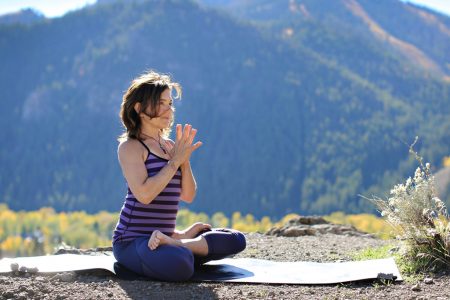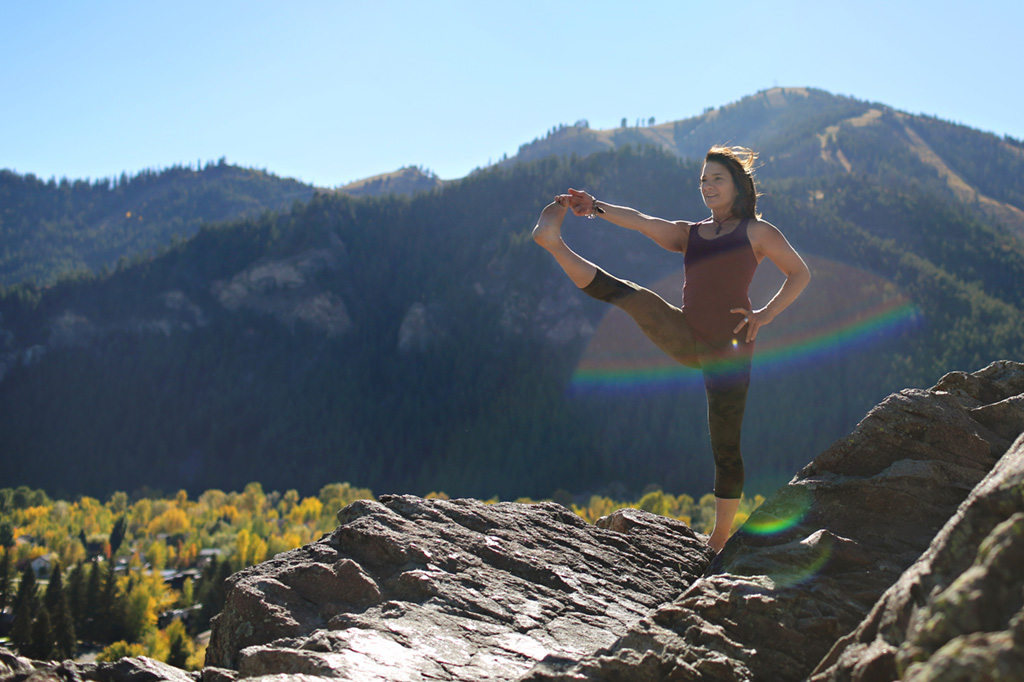If you have a body, do yoga.” That is the key message from Cathie Caccia, a Wood River Valley specialist in yoga instruction, yoga therapy, shiatsu, acupressure, and massage. “There are so many types of yoga. There are breathing practices, meditation, and physical, therapeutic, and rejuvenative practices. My recommendation is don’t get pigeonholed into thinking yoga is one thing. It’s so broad and so beneficial that it’s worth asking questions and finding a practice that works for anyone’s specific needs.”
In a place of constant movement like Sun Valley, a person’s specific “needs” in winter are usually related to shredding the snow. Whether you’re Nordic skiing, downhill skiing, or snowboarding, yoga can complement your winter days by building flexibility, strength, mind-body awareness, injury prevention, and injury rehabilitation.
Many professionals recommend incorporating restorative yoga into your ski or snowboard practice. Sun Valley Nordic Comp Team Head Coach Ashley McQueen Knox noted that the ski team incorporates yoga focused on gentle stretching and flexibility, building for 30 minutes every workout. “Nordic skiing is relatively easy on the body, but common injuries tend to be tight IT bands, which lead to hip or knee pain, shin splints from summer cross-training, and chronic compartment syndrome,” McQueen Knox said. “Having a balanced body, flexibility, and stretching can really help prevent injuries and improve overall ski performance and health in the short and long term.
“Everything is connected: if one thing is tight it’s going to present itself in another area. Something like yoga is really important for our skiers that are growing, gaining muscle, and working really hard.”
Locally, instructors Cathie Caccia, Lauri Bunting, Richard Odom, and others teach restorative yoga classes, particularly noted for being beneficial after downhill or Nordic skiing. Yoga instructors identify one value of yoga to be balancing out the intensity of skiing or snowboarding for anyone, not just athletes. Describing her personal experience, Caccia said, “How I really use yoga is for recovery after skiing. We have great skiing in Sun Valley, but whether we have groomed or a huge powder day, it can be hard on the body for everyone. When I do one one-hour sequence, I just feel recovered and so refreshed.”
 For restorative yoga poses after skiing or snowboarding, Caccia recommends inverted staff pose (raise and rest straight legs against a wall), and reclining hero pose (kneel, sit between your feet, and slowly lower your back as much as your body allows, making sure to immediately stop if any knee pain arises).
For restorative yoga poses after skiing or snowboarding, Caccia recommends inverted staff pose (raise and rest straight legs against a wall), and reclining hero pose (kneel, sit between your feet, and slowly lower your back as much as your body allows, making sure to immediately stop if any knee pain arises).
Practicing restorative yoga can present the challenge of “slowing down” for those more intense athletes. Laughing, Knox noted: “For the ski team, we incorporate yoga for flexibility, but also for body awareness and a challenge of going slow. We can have really, really good athletes, but then they try to get into yoga poses and don’t know what they’re doing. What I’ve found with our team skiers is that they have the mentality of, ‘Oh, it’s hard, so I can do it.’ But with yoga, you have to say, let’s take a step back and try something new and different. You have to build up slowly.”
The mental aspects of yoga can also complement skiing and snowboarding. Yogic meditation and breathing practices can help both new and experienced skiers and snowboarders with learning and perfecting skills, visualization, and mind-body awareness and connection. Returning to breathing practices learned in yoga, known as pranayama, can help individuals reduce anxiety and increase focus on and off the snow.
Practicing other types of yoga, such as vinyasa, hatha, and yin yoga, can also provide benefits and build such ski-related skills as increased agility and awareness of weight transfer and balance. Incorporation of yoga practices such as vinyasa and power flow can be used to build body strength that conditions for winter sports. In the Valley, offerings for this type of yoga include classes such as Beth Stuart’s Flow Till You Glow at idaYOGA in Hailey and Danielle Fuller’s Yoga Conditioning + Flow at Gather Yoga in Ketchum.
Other local studios also offer classes for higher intensity, strength-building yoga that is meant to build muscle and flexibility to complement time on the slopes. These classes specifically incorporate holds of specific ski-related postures, such as chair pose, a low squat with thighs parallel and arms stretching overhead that is akin to a tuck while skiing. The purpose of building strength particular to skiing and snowboarding through yoga is to increase performance and reduce soreness and proneness to injury.
When practicing any type of yoga, it’s crucial to “listen” to your body and stop if you feel any pain. “What works for me doesn’t mean it works for someone else,” Caccia said. “In yoga, it’s important to let your body be your guide. If your body is telling you, ‘This hurts!’ especially if it’s your knees or a joint, don’t push through. One of the biggest things you get with yoga is the dialog with the incredible intelligence of body. It’s silly to be in yoga, have your body tell you something, and not listen.”
Whatever yoga works for your body, the flexibility, strength, breathing, and mindfulness building of the practice just might be the perfect complement to the Sun Valley slopes.


